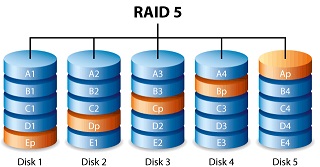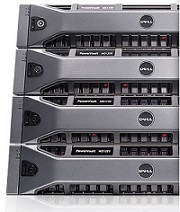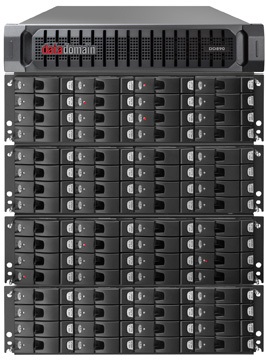RAID 5 Data Recovery, RAID 50 Data Recovery services
RAID 5 arrays are mostly used in a data warehouse solution where the number of READ requests is significantly higher than WRITE requests.  RAID 5 uses data striping to provide fault-tolerant data storage and doesn't require duplication of data like RAID 1 or RAID 10. Data is striped across all of the drives in the array. For each stripe through the array (one stripe unit from each disk) one stripe unit is reserved to hold parity data calculated from the other stripe units in the same stripe. This leads to improved read performance. However, there is a penalty for writes, since the parity data has to be recalculated and written along with the new data to the parity stripe unit.
RAID 5 uses data striping to provide fault-tolerant data storage and doesn't require duplication of data like RAID 1 or RAID 10. Data is striped across all of the drives in the array. For each stripe through the array (one stripe unit from each disk) one stripe unit is reserved to hold parity data calculated from the other stripe units in the same stripe. This leads to improved read performance. However, there is a penalty for writes, since the parity data has to be recalculated and written along with the new data to the parity stripe unit.
The RAID 5 controller itself can fail due to different circumstances and it is impossible to recreate and recover array. As a result, you have a number of disks, all containing your data but you cannot access that data. This is where you will need true RAID 5 data recovery services. The ACE Data Recovery engineers are experts in recovering RAID 5 arrays regardless of the reason for failure, even including crashed arrays with two or more drives down. Multiple drives down in a RAID 5 failure requires the right equipment and experience in order to preserve the highest chances for successful recovery.
What are the reasons of RAID 5 failure?

- Multiple hard drives failure
- RAID Controller failure
- Overheating
- Volume deletion or reformatting
- Wrong disk replacement
- Rebuild process interruption
The RAID 5 has long been the standard in server environments requiring fault tolerance. The RAID parity requires one disk drive per RAID set, so usable capacity will always be one disk drive less than the number of available disks in the configuration of available capacity. This is still better than RAID 1 which only has a 50% usable capacity. A RAID 5 array requires a minimum of 3 disks and a maximum of 16 disks to be implemented and its usable capacity is between 67% - 94%, depending on the number of data drives in the RAID array.
 A RAID 50, also known as RAID 5+0, implements a distributed parity (RAID 5) with striping (RAID 0) and requires a minimum of 6 drives. It combines two RAID 5 configurations into RAID 0 configuration. However, not every controller supports RAID 50. RAID 50 provides a great balance between storage capacity, array performance and data integrity that is not found in other RAID levels. Performance does not degrade as much as in a RAID 5 array because a single failure only affects one array. Up to 2 disk failures can be overcome as long as they affect different RAID 5 arrays. When you increase the number of drives in RAID 5, you also increase the probability of failure as more than one drive can fail at the same time.
A RAID 50, also known as RAID 5+0, implements a distributed parity (RAID 5) with striping (RAID 0) and requires a minimum of 6 drives. It combines two RAID 5 configurations into RAID 0 configuration. However, not every controller supports RAID 50. RAID 50 provides a great balance between storage capacity, array performance and data integrity that is not found in other RAID levels. Performance does not degrade as much as in a RAID 5 array because a single failure only affects one array. Up to 2 disk failures can be overcome as long as they affect different RAID 5 arrays. When you increase the number of drives in RAID 5, you also increase the probability of failure as more than one drive can fail at the same time.
Comparing with RAID 5 configuration, RAID 50 uses additional disk space for parity to lower the risk of system crash.
RAID manufacturers differ vastly in their designs of the internal components and circuitry of their hardware and an in-depth knowledge of these designs are crucial for successful data recovery. But because manufacturers do not disclose this information, RAID recovery techniques require many years of development and reverse engineering in order to determine which ones are the most effective.
Our RAID data recovery process meets manufacturer’s requirements.
We recover data from any hard drive RAID arrays made by but not limited to the following manufacturers:
Latest Publications
By following these guidelines and avoiding common mistakes, you can extend the lifespan of your flash drive and protect your valuable data
Read more..
Understanding and Unraveling the Mystery of Formatted SSDs: Can Deleted Data Be Recovered?
Read more..
